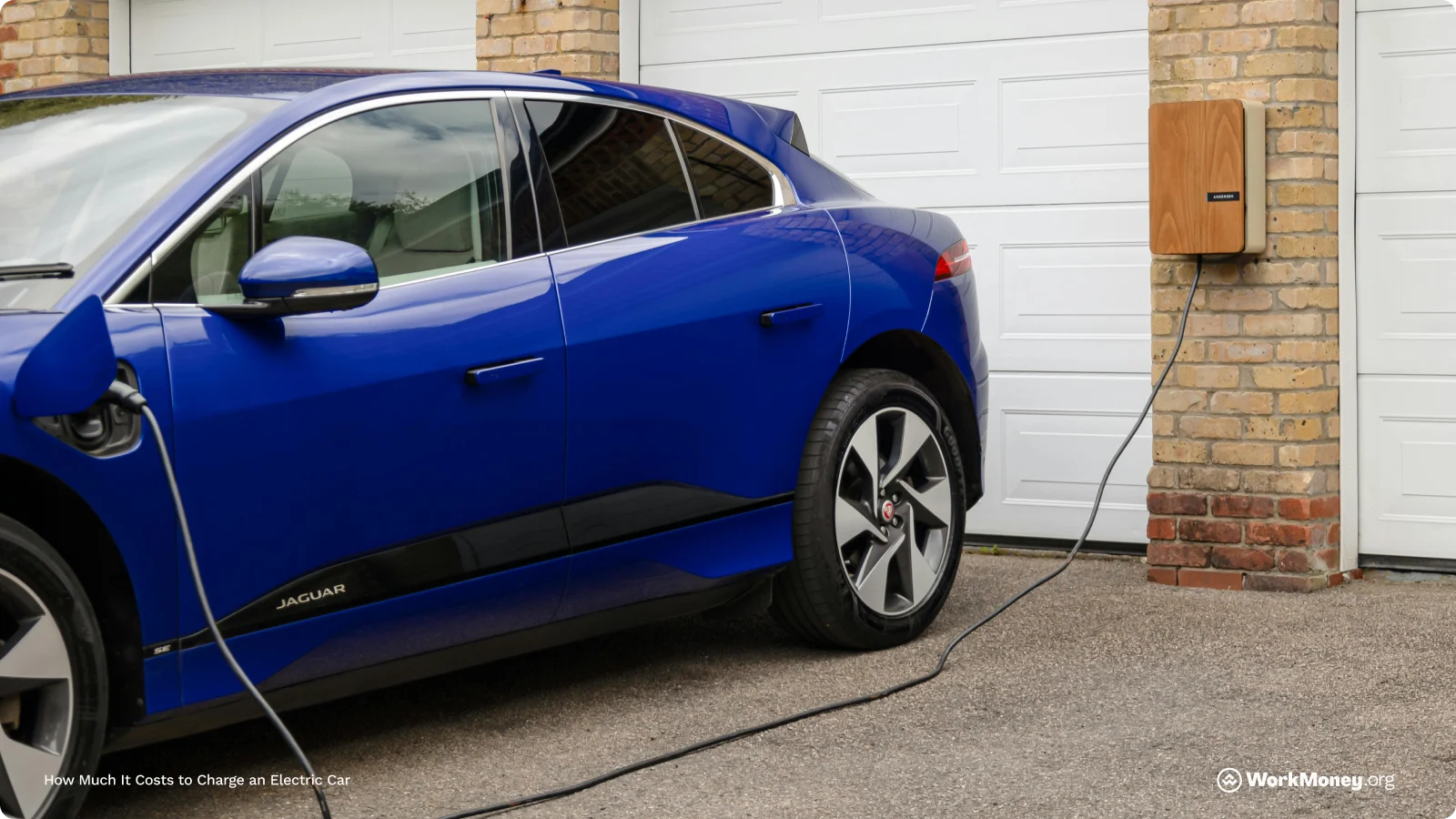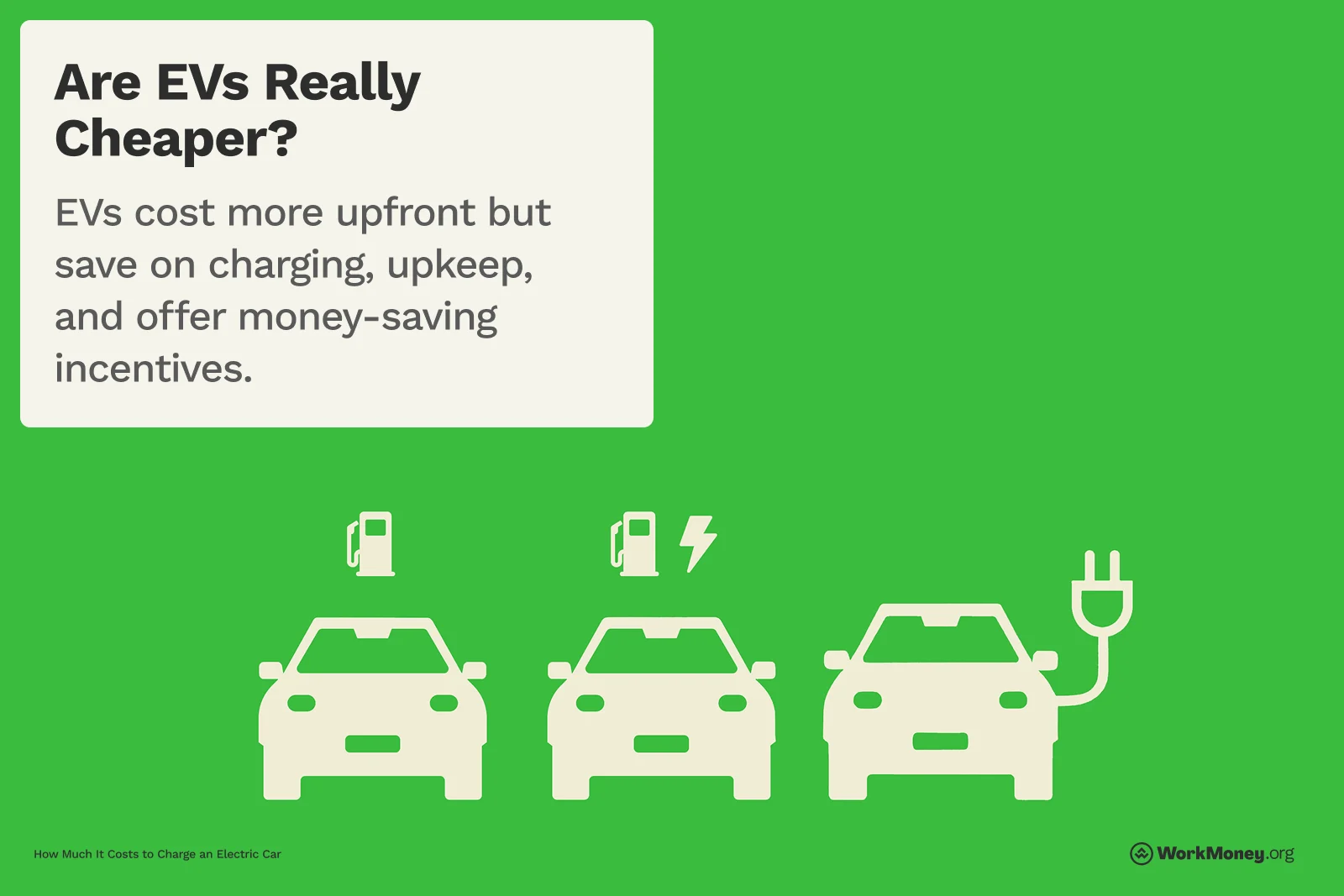How Much It Costs to Charge an Electric Car
Thinking of going electric? Learn what it really costs to charge an EV at home or in public, and how to save with rebates, free charging, and smart planning.

Electric vehicles are becoming a staple for consumers to consider when buying a car. About a quarter of Americans would consider an EV for their next vehicle purchase, according to the J.D. Power 2025 US Electric Vehicle Consideration (EVC) Study. However, the total amount of EVs on the road in the U.S. is a mere 1%, according to Edmunds.
EVs can be a great way to eliminate your gas bill, but there are costs associated with charging to consider. And just like gas prices, the cost of changing an electric car can vary. At WorkMoney, we aim to save you the most money possible, including on the vehicle you drive.
Here’s what you need to know about how much it costs to charge an electric car, and how you can save on those charging expenses.

How EV Charging Works
When you buy any electronic equipment (a TV, a new phone, etc), you have to have a plan in mind to charge/power the equipment. Purchasing an EV is no different.
Coming up with an EV charging solution is no different. It comes down to several factors, including: budget, time, convenience, where you park, where you live, and more.
If you’re considering buying an EV and are thinking about how you may charge it, here are the Level 1, 2, 3 solutions you need to know.
Charging Level | Power Source | Charging Speed | Typical Use | Pros | Cons |
|---|---|---|---|---|---|
Level 1 | 120V AC (standard household outlet) | 2–5 miles of range per hour | Home, overnight charging | - No installation required - Cheapest setup | - Very slow - Inconvenient for long daily commutes |
Level 2 | 240V AC (like a dryer outlet) | 10–60 miles of range per hour | Home, workplace, public stations | - Fast and efficient - Good for daily charging | - Requires installation - Upfront cost ($500–$2,000) |
Level 3 (DC Fast Charging) | 400V–900V DC (commercial-grade) | 100–250+ miles of range in ~30 min | Public charging stations | - Super fast - Ideal for road trips or emergencies | - Not for daily use - More expensive - Not all EVs supported |
Each of these chargers serve a different purpose. Here are a few situations where each may work:
Level 1
If you don’t drive often or have a minimal commute
If you have access to a household plug near your vehicle
Portable and can be taken on the go
Investment for Level 1 charger: $100-200
Level 2
If you drive longer distances regularly and need to maintain a full battery
These can be found at shopping centers, grocery stores, etc.
Investment to buy and install Level 2 charger at home: $500-2,000
Level 3
If you’re on a road trip or need to charge your battery quickly
These can be found at gas stations, supercharging stations, and other public places
It’s advised to use these sparingly as they can wear down the battery life span
How Much Does It Really Cost to Charge an EV at Home?
Aside from the equipment, the costs of charging an EV at home will vary widely based on what your kilowatt per hour (kWh) price is. This can range from pennies an hour, to up to $0.50 an hour.
Here’s how to find the numbers and run the math:
Step 1: Find your electric bill. You should see the kWh price you are being charged.
Step 2: Find the number of kilowatts it takes to charge the car battery. You can find this by searching for the EV make and model’s battery size.
Step 3: Take both numbers, and input them into this calculator. This will give you a rough estimate of how much it will cost.
In addition to charging, consider the full ownership costs of both gas-powered vehicles and EVs.
Category | Internal Combustion Engine (ICE) Vehicles | EVs | Winner |
|---|---|---|---|
Fuel/Energy Cost | $3.12/gal (25 MPG = 13¢/mile) | US average energy price is 17¢/kWh (The average EV gets 0.3 kWh/mile = ~4¢/mile) | EV (Cheaper to run) |
Maintenance | EV (Lower maintenance) | ||
Purchase Price | Lower upfront ($25K–$40K average) | Higher upfront ($35K–$55K average) | |
Incentives & Tax Credits | Limited | Up to $7,500 federal (could be going away) + local/state rebates | EV (More incentives) |
Charging vs Gas Access | Gas stations everywhere; quick refuel | Charging stations expanding; home charging available | ICE (Faster fueling) |
Typically lower | ICE (Lower insurance) | ||
Resale Value | Stable depending on model and gas prices | Contextual |
If you have an auto loan with a high interest rate, you may be able to refinance it to a lower rate through Caribou.
Public Charging: What to Expect
If you don’t have access to a home charger, you will have to rely on the public charging network. Unfortunately, this remains a significant pain point for EV drivers, and one of the largest reasons potential buyers haven’t made the switch. There aren’t enough EV stations currently, and the available ones have proven to be unreliable in some cases.
To get a grasp on the public charging network, visit PlugShare. It will give you a full view of your area, and where there are charging stations. You can even filter to see where there are free chargers.
There are a few things to do in preparation before using a public charging station:
Sign up for charging accounts. Each charging station is run by a different company. Be sure to sign up and attach a payment method for a simpler payment process.
Know your EV plug type. There are a couple different plug types across different EVs, and the public charging network will have different charging ports available. There are adapters readily available on Amazon you can purchase to ensure you have access.
Etiquette. If you’re at a busy public charging area, it’s likely there may be a line of cars waiting to charge. It’s best to stay near your car so when you’re done, you can leave quickly so the next person can use it.
Help for Lower-Income Families
There are several financial resources and incentives available for lower-income families to afford an electric vehicle.
When it comes to purchasing an electric vehicle, there is the Clean Vehicle Credit, where you can get up to $7,500 back on the purchase of an electric vehicle. This is based on your adjustable gross income (AGI) on your tax filing. Additionally, there are incentive programs offered by states and utility companies to offset the costs of EV charging equipment. You can find out info about this through your utility company.
But the best way to cut down ownership cost is relying on free charging stations.
Final Thoughts: Is EV Charging Affordable?
EV charging can be affordable, and even much cheaper than paying for gas. There is no one charging solution that makes sense for EV owners, so be sure to create your solution and run the numbers before buying.
The upfront costs of buying an EV can be higher than a traditional gas powered vehicle, but the long-term savings can give you a lower overall cost of ownership.
About the Author

Brett Holzhauer
Brett Holzhauer is a Certified Personal Finance Counselor (CPFC) who has reported for outlets like CNBC Select, Forbes Advisor, LendingTree, UpgradedPoints, MoneyGeek and more throughout his career. He is an alum of the Walter Cronkite School of Journalism at Arizona State. When he is not reporting, Brett is likely watching college football or traveling.
